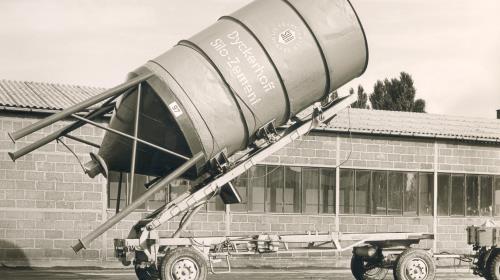History - Dyckerhoff Germany

- History 1864 – today
1864 – 1935
On June 4, 1864 the „Portland-Cement-Fabrik Dyckerhoff & Söhne“ was founded in Amöneburg.
1864 – 1935
Wilhelm Gustav Dyckerhoff founded the "Portland-Cement-Fabrik Dyckerhoff & Söhne" in Amöneburg on June 4, 1864 together with his sons Rudolf and Gustav. Twenty years later the company could proudly call in the biggest order from the USA for that time: Dyckerhoff delivered 8,000 wooden barrels of cement for the foundation of the Statue of Liberty. In 1909, the production with the first rotary kiln began. In 1931, an important product innovation launched the market: the white Portland cement "Dyckerhoff Weiss".
1936 - 1984
As the first building material supplier Dyckerhoff transports cement in special silo trucks to the construction sites.
1936 - 1984
From 1949 on, as the first building material supplier, Dyckerhoff transported cement in special silo trucks to the construction sites and stored it at site in silos. In 1959 again, the company implemented an innovative process: the usage of dry kilns with preheaters. At the same time Dyckerhoff started producing ready-mixed concrete. After 1963 Dyckerhoff aimed at going abroad, first of all to Spain and entered in 1973 the Luxembourgian market.
1985-2007
Dyckerhoff expands to Eastern Europe.
1985-2007
With the market entry into Russia in 1994 the company expands to Eastern Europe. Until 2000, market entries into Poland, the Czech Republic and the Ukraine followed. By returning to its core competencies, Dyckerhoff changed its strategy. The Italian company Buzzi Unicem S.p.A. joined Dyckerhoff by gaining 30 % of the common shares and 4 % of the preferred shares in 2001 and increased its shares steadily over the years. In 2004 Dyckerhoff merged the US business with Buzzi Unicem’s RC Cement to RC Lonestar. In the new company Dyckerhoff holds a share of 48.5 %, Buzzi Unicem holds 51.5 %.
From 2008
Buzzi Unicem increases its shares in Dyckerhoff to 100 %.
From 2008
In 2013, Buzzi Unicem increased its shares in Dyckerhoff to 100 %. In order to integrate Dyckerhoff deeper into the Group, the company's legal form was changed to limited liability corporation (GmbH). Due to the acquisition of the Lafarge subsidiary "Uralcement" (today "Dyckerhoff Korkino") by Dyckerhoff GmbH, Buzzi Unicem not only increased the Russian production capacity to 4.7 mn tons, but also strenghened its position in the Ural region.
Ab 2015
Vier Zementhersteller gründen Forschungsgesellschaft
Ab 2015
Am 6. Dezember 2019 schließen sich Buzzi Unicem - Dyckerhoff, Heidelberg Materials SCHWENK Zement und Vicat in der Forschungsgesellschaft CI4C - Cement Innovation for Climate - zusammen. Ziel des Unternehmens ist die Realisierung des Forschungsprojekts "catch4climate", das die praktische Anwendbarkeit der Oxyfuel Carbon Capture Technologie im Zementherstellungsprozess untersuchen wird.






